#show don't tell
Text
show, don't tell:
anticipation
- bouncing legs
- darting eyes
- breathing deeply
- useless / mindless tasks
- eyes on the clock
- checking and re-checking
frustration
- grumbling
- heavy footsteps
- hot flush
- narrowed eyes
- pointing fingers
- pacing / stomping
sadness
- eyes filling up with tears
- blinking quickly
- hiccuped breaths
- face turned away
- red / burning cheeks
- short sentences with gulps
happiness
- smiling / cheeks hurting
- animated
- chest hurts from laughing
- rapid movements
- eye contact
- quick speaking
boredom
- complaining
- sighing
- grumbling
- pacing
- leg bouncing
- picking at nails
fear
- quick heartbeat
- shaking / clammy hands
- pinching self
- tuck away
- closing eyes
- clenched hands
disappointment
- no eye contact
- hard swallow
- clenched hands
- tears, occasionally
- mhm-hmm
tiredness
- spacing out
- eyes closing
- nodding head absently
- long sighs
- no eye contact
- grim smile
confidence
- prolonged eye contact
- appreciates instead of apologizing
- active listening
- shoulders back
- micro reactions
#lyralit#writing tips#writerblr#creative writing#writblr#writers#writing#writers block#writing ideas#writing prompts#writing help#writing advice#writing resources#writing characters#emotions#show don't tell#describing#writing prompt
89K notes
·
View notes
Text
Here are some examples of "show, don't tell" in action:
Telling: Sarah was very angry.
Showing: Sarah's face turned red, her fists clenched, and she slammed the door shut.
//////
Telling: The room was messy.
Showing: Clothes were strewn across the floor, books were piled haphazardly on the desk, and dirty dishes filled the sink.
//////
Telling: John was scared of heights.
Showing: John's palms grew sweaty, his heart raced, and he clung tightly to the railing as he looked down from the rooftop.
//////
Telling: The food tasted delicious.
Showing: The flavors exploded on her tongue, a medley of sweet, tangy, and savory notes danced in her mouth, leaving her craving more.
//////
Telling: Emma was sad about the breakup.
Showing: Emma's eyes welled up with tears, her shoulders slumped, and she spent hours curled up in bed, replaying their last conversation in her mind.
//////
Telling: It was a beautiful sunset.
Showing: The sky transformed into a canvas of vibrant hues—pinks, oranges, and purples blending together in a breathtaking display, casting a warm glow across the horizon.
//////
Telling: The car was old and unreliable.
Showing: The engine coughed and sputtered, emitting puffs of smoke. Rust covered the body, and the faded paint revealed years of wear and tear.
//////
Telling: The meeting was tense.
Showing: The participants leaned forward in their seats, their brows furrowed, and their voices became sharp and clipped as they argued back and forth.
//////
Telling: He was a kind person.
Showing: He often went out of his way to help others, offering a comforting smile and lending a listening ear whenever someone needed support.
//////
Telling: The forest was eerie at night.
Showing: Shadows danced among the trees, the wind whispered through the branches, and the distant hooting of an owl sent shivers down her spine.
#show don't tell#writing#writing tips#writer on tumblr#writerscommunity#writer tumblr#writblr#writing advice#writing help#creativewriters#writing ideas#writer problems#writers on tumblr
3K notes
·
View notes
Text
How to write romantic love
Writing romantic love is simultaneously one of the most joyful things you can do as a writer, and one of the most difficult. There’s a lot of emotion to cover - from the highs of a new relationship, to the struggles of a relationship on the rocks.
Like all of us, your characters will display love differently. Are they open and affectionate? Shy and nervous? Loud and blunt? To help you along the way, here’s some examples of descriptions you can use to show (not tell) your readers that your characters are in love.
Movement
Inching towards each other to touch
Shyly tucking stray hair behind the ear
Unconsciously parting or licking lips
Embracing with full bodies touching
Nervously shuffling feet
Running and reaching with open arms
Fiddling with hair or clothing
Crossing or uncrossing legs
Leaning forward to show attentiveness
A bounce in the step
Glancing flirtily over the shoulder
Facial expressions
Flirtatious winking
Smiling to themselves at nothing
Glancing up through lowered lashes
Unblinking eye contact
Grinning or beaming uncontrollably
A look of yearning
Lips slightly parted with desire
Dilated pupils
Glowing cheeks or flushed skin
Faraway, daydreaming look
Slight, secretive smile
Sounds
Deep sighs
Unconscious swallowing
Nervous coughing or throat clearing
Light chuckle with a silly grin
Grunts of appreciation or praise
An inner, audibly racing pulse
Thumping heart
Quick, short breaths
Low, whispered voices
Listening to love songs
Joyfully humming
Feelings and sensations
Nervous tingling
Butterflies in the stomach
Hot and flushed face
Hyper-sensitive skin
Acute awareness of personal proximity
Weak knees or legs turning to jelly
Shaky hands
Loss of speech or getting tongue-tied
Daydreaming and absentmindedness
Seeing the beauty in the world
Pulse racing
#writing#writers#creative writing#writing about love#writing romance#romantic love#novlr#writers of tumblr#writerblr#show don't tell#descriptive writing#writeblr#writing tips#writing advice#writing inspiration#creative writers#writing characters#learn to write#writing help#writing resources
4K notes
·
View notes
Text
Update: It turns out that this isn't quite true, so if you see this, please check out the correction over here, thanks!
So apparently, "show don't tell" was pushed as Really Good Writing Advice in the 1950's because it kept writers from discussing political ideas that challenged the status quo.
Which like... obviously, "show, don't tell" can be useful sometimes, like if you're describing a terrifying monster! But pushing it as The Only Way To Write would definitely have a chilling effect on stories centering concepts and experiences unfamiliar to readers.
I find it both fascinating and a little disturbing how effectively censorship can be accomplished through simply convincing people that certain forms of expression are gauche.
2K notes
·
View notes
Text
Tips For "Show, Don't Tell."


Honestly, show don't tell is something I feel even I struggle with and I'm pretty sure anyone who writes faces it. Finding a balance is hard. When to show and when to tell can become an inherent feeling though. However, there are some things I've learnt and I hope they help you!
❥︎Emphasise Sensory Detailing: Not only does packing a scene with sensory details help readers imagine the setting, it also gives your characters a distinct physical world to interact with. Rather than simply saying that a character is in New York, describe the light reflecting off the Hudson River, or the towering colossus of the Statue of Liberty.
❥︎Describe body language and avoid emotional explanation when showing.
❥︎Like I said, focus on describing senses and lean more on the usage of imagery too, it'll help if you understand that literary device. I have a post on how to use imagery in writing which helps a lot when showing and not telling. Pick adjectives that you use to describe and replace them with sensory descriptions. Eg:
+ He was scared when he saw the lion at the exit.
+ His heart raced when he saw the lion looming at the end of his escape route.
See what I did here?
Did you feel the difference?
❥︎ learn from examples of 'Show, Don't tell' by reading. The most basic.
❥︎ Use of Dialogue: can also teach readers about characters through word choice, tone, and POV. For instance:
The tray flipped and drenched her in wine. She shrieked and jumped out of her seat, glaring at the waiter.
And
The tray flipped and drenched her in wine but all she did was sigh and smile in understanding.
The scene is the same but the character's approach was different in each case. The former seems kind while the latter seems to be a temperamental character.
❥︎Make your character do something out of ordinary, something that breaks the routine or would make a heavier impact. For eg:
If a character speaks in long-winded, erudite sentences, readers might gather that they are pompous and well-educated. If this same character suddenly begins speaking in terse, short bursts later in the novel, readers might note that something in that character has shifted.
If they're described as someone who never cooks say and then at some time they cook for the live interest, it'll pique the reader’s Interest because it was uncharacteristic of them to do.
❥︎Having a diverse vocabulary, imagination and the ability to use literary devices like metaphors will greatly aid in Show don't tell.
❥︎And lastly, It's fine if you don't get it right the first time because that's how writing works. The more you read, attempt and err, the more you learn. But having an idea of what to do will go a great way in guiding and saving time.
Hope it helps! Follow for more, like and share! <3
#show don't tell#how to write#writing tips#writing advice#writerblr#books#writers#readers of tumblr#daily life#bookaddict#writing a book#writers on tumblr#writing ref#writing prompts#reader problems#dank memes#book blog#booklover
2K notes
·
View notes
Text
📝 Emotion, atmosphere and environment: A writing exercise for show-don't-tell
Before we go any further, I want to make it clear that I'm not aggressively against telling. Sometimes telling works for a whole bunch of valid reasons. If you know me at all, you'll be aware of where I stand on the issue of narrow, prescriptive writing rules (if you don't know me, hi, I despise narrow, prescriptive writing rules)
But "How do I show instead of telling?" is still a thing a lot of newer writers have difficulty with and that's what I'd like to dig into. So here's a writing exercise you could try to help build depth and atmosphere around the emotion your character is feeling...

🧠 First of all, pick an emotional experience.
For illustrative purposes, I'm going with LOSS. Then express that emotional experience in ways that can be perceived physically. The following are just suggestions, not an exhaustive list.
🎨 How could the emotion be expressed as a colour?
Grey, maybe. Slate grey. Or a muted petrol blue, perhaps.
🔊 How could the emotion be expressed as a sound?
Deep silence interrupted only by the sound of a ticking clock.
👋 How could the emotion be expressed as a physical action?
Your hand reaching to grasp for comfort out of habit and hope, fingers curling around something remembered, then dropping back to the coldness of the other side of the bed, empty.
🌄 How could the emotion be expressed as a weather condition or natural phenomenon?
The storm passed an hour ago, leaving only an occasional flurry of sleet that melts on contact with the window, sliding down the glass like tears. Outside, a tree that shed its leaves in autumn bows in tired silhouette against the halo of a single streetlight.
🏡 How could the emotion be expressed as a room?
Your nightstand holds the bottle of water you filled before trudging upstairs at midnight, your phone still plugged in even though the battery was full three hours ago, and the glasses you'll put on again as soon as you wake up after sleep eventually manages to swallow you. The nightstand on the other side of the bed holds a small tear-off calendar showing November eighteenth even though it's now January second and a book lying open and face-down with the spine sinking into itself. In the corner of the room, there's a chair with clothes carelessly draped over it a month and a half ago that you still can't bring yourself to put in the laundry. It's four o'clock in the morning and you'd give anything to hear breathing that wasn't your own.

You could try it for different emotions and different situations, in isolation and then connected to something you're in the process of writing.
How could anger, for example, be expressed differently in an office environment compared to a wilderness landscape? How could joy be shown in summer versus winter? How could fear be embodied in high fantasy compared to cyberpunk?
If relating environments to emotions doesn't click for you straight away, could you focus on single-sense experiences for a while? What colour is regret? What does anticipation taste like?
If you have synesthesia (hello, fellow synesthetes!) this could be a wild ride, but hopefully it'll also be fun and useful for anyone having difficulty connecting to the idea of show-don't-tell.
Happy writing! 💜
#writeblr#writing advice#writing tips#show don't tell#writers on tumblr#writeblr community#the shit in my head
170 notes
·
View notes
Text

Think of this as a post-it note about showing instead of telling.
#writers#writing#writers on tumblr#writing community#writer things#writerslife#writerscommunity#novel writing#writers and readers#writing tips#show don't tell#writing advice#creativewriters#writer tumblr#writing resources
391 notes
·
View notes
Text
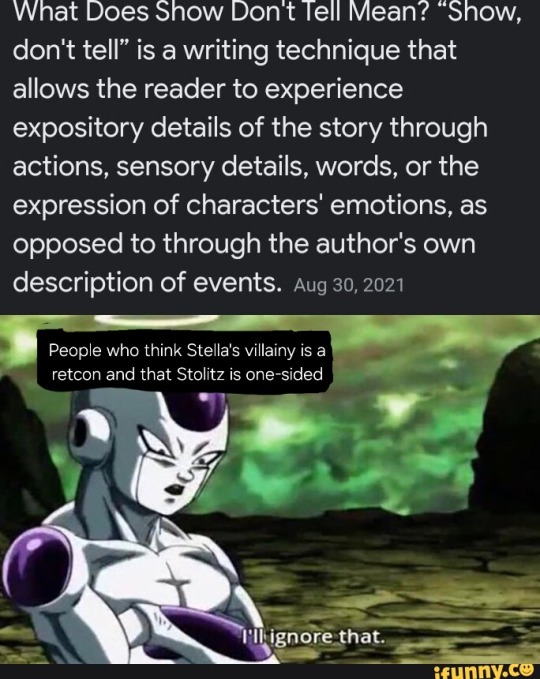
See, this is what happens when people don't count important details in storytelling just because it's not being said outright, but rather shown through character expressions without dialogue. There were hints from the beginning that Stella was always meant to be a bad person and an obstacle to Stolas' feelings for Blitzø.
Don't believe me? Watch Loo Loo Land again with more open ears and eyes. Stella is shown throwing stuff at Stolas, including his sentient plants which he values highly and she was likely aware of that. That imp butler she threw at him means she not only abuses Stolas, but her own servants too, especially those of a particular lower class race.
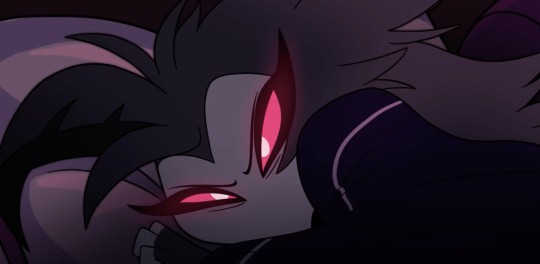
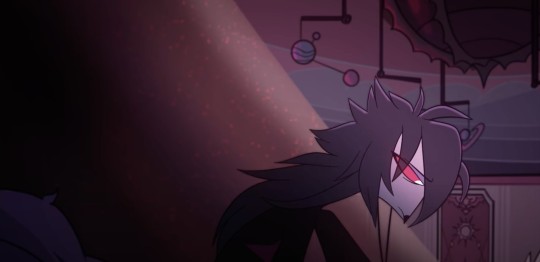
Octavia's expressions here imply that this isn't an isolated incident either. That's the look of a girl who's heard this same type of arguing from her parents everyday. With how annoyed she looks, Stolas and Stella might as well have been fighting like this for years. It'd be more surprising if they didn't.

Octavia's lack of a reaction to her mom throwing a plant that almost hit her implies that this is far from the first time Stella has thrown things around the house. That is a concerning thing to get used to. Stella is also heard yelling about Stolas sleeping with an IMP, in THEIR bed. Notice the emphasis on "imp" and "our" bed. Even Stolas' only response to that is "I didn't have time to go to a motel!" It's pretty clear here that Stella is more concerned about about Stolas cheating on her with an imp specifically and ruining her reputation than the fact that he cheated at all.
If she was truly upset about the cheating itself, she would've said something more along the lines of "I can't believe you slept with someone else!" or something like that. Throwing their imp butler and him saying "You wanna fuck this one too?" and calling Stolas "pathetic, imp-sucking face" is all you need to know that Stella is making it more about WHO Stolas cheated on her with than the fact that he cheated. Keep in mind that this argument was going on right in front of Via, who didn't even say anything or try to stop it.

Octavia here says "You two done screaming for the day?" with little emotion, and Stolas' reply basically amounts to "Yup" without hesitation. More and more proof that his marriage with Stella was NEVER happy and never something that he wanted.
Later in the episode, Via does say that her parents used to love each other, even though we as the audience know it's not true. Stolas even tries to explain to her that he and Stella were never in love to begin with, but he didn't have the words. Because how exactly can you explain to your daughter that you and your wife were in an arranged marriage since you guys were kids for the sole purpose of producing a child, without offending her and making her think she was only born for one purpose? Or better yet, what reason is there to assume that she'd actually believe you?
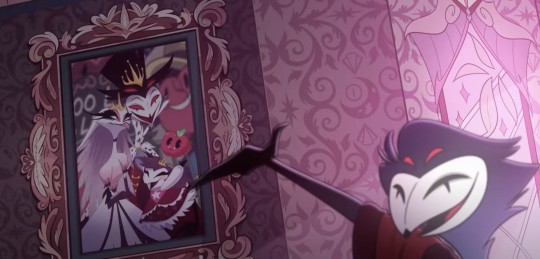
People have looked at this picture on the wall and somehow came to the conclusion that Stolas and Stella used to be in a happy, loving relationship based on this picture alone, just because Stella is smiling in it. But if you look cloesly, you'll see that smile on Stella is barely there. She's very obviously faking it to keep up an image. She's forcing it so people won't get suspicious. This is the vision of Stella that Octavia remembers from her youth, which is exactly why she was naive enough to believe that her parents genuinely loved each other before Blitzø came along for a one night stand in hopes of getting the grimoire. Sure, she had seen them arguing and fighting with each other before that, but that's mainly because most if not all parents have gotten into nasty arguments at some point that their children were more likely than not to witness.
Stella is barely looking at Stolas there, clearly rolling her eyes and just wanting the picture to be overwith already. Stolas is genuinely happy there, but that's because his "little owlette" is there with him. He's not looking at Stella at all. Another picture in their house with just Stolas and Stella together has both of them frowning and looking at the camera, not each other. Octavia is the only thing to come out of Stolas' marriage that ever gave him any real happiness. She was the only reason he stayed at that house.
That scene where Stella ignores Octavia's cry for help when she's having a nightmare and tells Stolas to go check on her instead is more evidence that Stella had never been a nice person or a good mother. You could argue that she was just too tired to do anything about it, but look again. Stolas was just as tired as she was, yet he still went out of way to comfort his "little Starfire" when she was having a bad dream. Octavia may have called for both of her parents, but she said she had a bad dream about her father disappearing. Not her parents, just her father.
Also notice the drawings in Octavia's bedroom when she's a child. Look at how many of them are of her and Stolas together, but Stella is nowhere to be found in those drawings. That shows how close Via is to her father, especially when she was a little girl, but was never really close to her mother at all. Sure, those drawings are no longer in Via's room when she's a teen in the present, but remember that her and Stolas gradually got less close to each other as the years went by and their relationship got more flawed, to the point that Via questions if her dad even loves her anymore and literally listens to music about hating dads. But the fact remains that there were never any drawings of Stella in her daughter's room and there still isn't now is pretty telling that Stella was never a good mom, still isn't now and likely never will be.
Now look at The Harvest Moon Festival. If Loo Loo Land didn't convince you that Stella was a bitch, then this episode sure will. Stella's only scene in the episode is her screaming into a phone while she's talking to Striker about wanting Stolas dead. Right in front of him and Octavia. While Via is listening to music that's too loud for her to have even heard the screaming, Stolas heard it pretty clearly. But he had no reaction to his own wife screeching about hiring an assassin to kill him. Him being completely unphased by something like that is surely a sign that Stella had always hated his guts and he knew about it. He likely heard her shouting at the top of her lungs about wanting to murder him with her own bare hands. If he's not reacting to Stella talking to Striker on the phone about planning his death in front of him, he might as well have been hearing shit like that from her for years.
Not counting the pilot, those are the only two scenes with Stella in season 1. Both scenes depicted her in the same light. A loud, violent bitch in a loveless marriage. Therefore, her reveal in The Circus about always hating Stolas from the get go is not a retcon. Not that there was even much known about her character for there to be retconned in the first place, but her few scenes before that episode showed her doing and saying nothing BUT horrible things.
As for Stolitz, Blitzø is more than once implied to return Stolas' feelings for him. He just never said it out loud and is in denial about his own feelings. He's not even aware that Stolas' love for him is genuine because between their reuniting at the Not Divorce Party and their fumbled fake date at Ozzie's, Stolas has only ever talked to Blitzø with sexual innuendos. So Blitzø had no reason to assume that Stolas was legitimately in love him and didn't just want him for sexy times, because Stolas hadn't really been helping his case. Blitzø ranted to Fizzarolli about Stolas "acting" like he cared about him outside of sex.

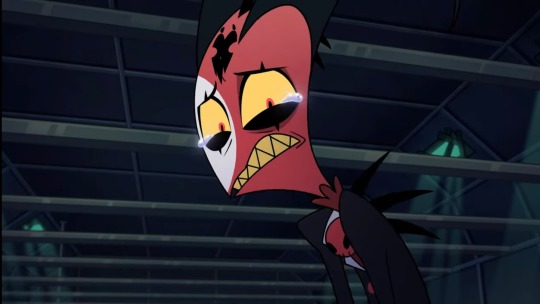

Everytime Blitzø talks about Stolas treating him like his own personal fuck toy, he looks and sounds pretty upset about it. I doubt he'd care all that much about his relationship with Stolas being transactional fucking if he didn't like him back. Right after the fake date gone wrong at Ozzie's, Blitzø is looking at several pictures saved in his phone, one of them being a photo of him Stolas laying together in bed. Blitzø looks genuinely happy in that photo, he's even smiling. He DOES enjoy being around Stolas. After Loona comforts him, he can be heard whispering the names of all the people he cares about and is close to. Those people being Loona, Moxxie, Millie and.... Stolas.
In Seeing Stars, Blitzø blushes when seeing Stolas in his human form and you can see his pupils dialating for a few seconds before he changes for a few seconds. I don't know about you, but I don't blush at anyone i'm not in love with when they get a new look. Pupils dialating are also a commom indication that you're looking at something you love. Later in that episode, Blitzo nervously sweats when Stolas whispers into his ear with a seductive voice, smiles at Stolas specifically when he causes the whole audience to laugh, and holds his hand while they run out of the burning building. Blitzø did not need to hold Stolas' hand. He could've just said "Hey, let's get the fuck outta here," and Stolas wouldn't have hesitated. On top of that, they are still shown holding hands long after they escaped and only let go once they see their daughters.
Now, onto the most complicated scene involving the Stolitz relationship, during Blitzø's ball tripping hallucination where he sees Stolas on top of a staircase and is being pulled towards him with chains. Already not a good sign. But Blitzø was already climbing the staircase before the chains appeared. Even when he saw Stolas above him, he didn't run away. He briefly walked towards him before being dragged towards him. He's seen blushing once he reaches the top and Stolas caresses his face. Also notice how the art style in Blitzø's ball trip sequence was completely different from how the show normally looks, but the moment he saw Stolas the art style changed back to normal. Meaning that Blitzø feels the most like himself when he's around Stolas.
He just wants to be in a legit, healthy relationship with Stolas out of love, not the transactional fuck buddy situation he's in right now. He wishes that Stolas would stop calling him degrading nicknames like "impish little plaything" and is bothered by the power imbalance between the two of them.
"Show, don't tell" is an important writing tool that isn't respected these days. If a story isn't being anvilicious and spoonfeeding you information with heavy-handed exposition and infodumps left and right, then foreshadowing details get dismissed and ignored, with some people straight up saying they don't count because it's not being spelled out to them every 5 seconds. This is why some people still insist that Stella's villainy was retconned and that Blitzø has no interest in Stolas despite evidence to the contrary. They were paying more attention to their headcanons than what the show actually presented, and got mad when their headcanons were contradicted by canon.
#helluva boss#blitzø buckzo#stolas goetia#stella goetia#octavia goetia#stolitz#character analysis#show don't tell
77 notes
·
View notes
Text
Throughout the journey, he has been slowing down his pace


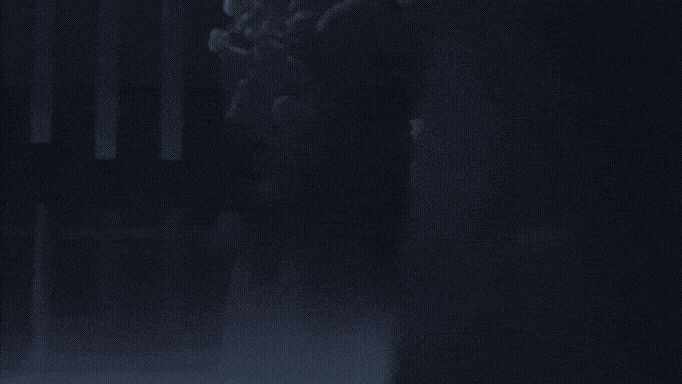
But I think it's here, at the very end, that he's the most stunning.
You might say resignation is guiding him at this point, but I don't think so.
Fear turned into acceptance. And bloomed into grace.
#graceful vash#graceful boi#this man is so tired and done with everything poor sunflower#someone give this boy a sandsteamer of hugs#vash#vash the stampede#character development told just by walking#masterful storytelling by animation#show don't tell#trigun#trigun stampede#trigunalysis#tristamp
605 notes
·
View notes
Text
Writing Advice: Characterization
Writing characters can be really hard, and conveying personality to readers is just as difficult
I'm expert in this and I'm studying so take my word with a grain of salt
Here are some tips on writing characterization
Show don't tell of characterization
I'm sure my fellow writers are exhausted of hearing show don't tell, especially cause it's difficult to remember to do or master
And there's a lot of different ways to implement it, but I feel it means even more for characters because it gives you a chance to explore their personality
Sometimes it is better to tell, but many times showing grants you an upperhand take for example:
Character A was furious. Character B's voice was annoying them only further. They were ready to punch them in the face.
This can work, however it can easily bore the reader and goes little in the character or world themselves.
Character A glared at Character B, their arms tightly crossed, and leg impatiently tapping. All they could do was roll their eyes as Character B spoke. After all it got their mind off punching B in the face.
This is sentence shows more of the character. It shows that they have an attitude, and are more prone to punching people. I'm not good at explaining show don't tell, so I suggest looking into it, and remember that the rules aren't set in stone either.
Complexity
Character complexity helps aid the reader's suspension of disbelief and makes the characters feel more people-like. Not every character needs to be complex, and sometimes complexity isn't meant for one at all.
However it helps solidify a character, add more potential conflict to a story, and remove one-dimensionality.
Often times many stories start with one-dimensional characters and as installments and exploration increases, even the most silly characters become complex serious designs.
3 ways I prefer to show complexity
Show a character's thought process. Don't drown the reader in it, but dabble in character thoughts at moderate levels. Ig can help pacing anyway.
Give character groups opposing ideologies, beliefs, and ideas. Then show how these characters respond to them.
Give your characters bad traits and flaws. Don't stray towards hate-able personality, but understand that the world isn't black and white and neither shall your character be. The easiest way to do so and keep things complex is by extending already set positive traits. A character kind. Have them be too kind, let people go or trust people who shouldn't be trusted. Or they are kind to only certain groups of people, and need to learn to grow out of it.
Action
Actions, I'm not just talking about what your character does, although that is important too. Show me the character through how they do things, especially good to split up dialogue.
For example
Character A and B watched TV
This sentence works perfectly however if it is a moment where you're trying to characterize it can be utilized. For instance
The TV was playing a horror movie. Character A's eyes stayed glued to it, ignoring the fact that Character B was already clinging to them.
This tells you a lot more about the characters, and establishes a dynamic between the two as well.
Anyway that is all I can think off I hope this helps
#writing advice#writing advise#writing tips#writing hints#writing characters#characterization#writing#how to write characters#show dont tell#show don't tell#writing help#writing complexity
986 notes
·
View notes
Text
How to show or tell appropriately
People scream show don't tell at writers all the live long day, but honestly, we need a little tell with our show. Just like in real life I can't read minds to know exactly what something means, I can't read the character's minds even when I can. Having the thoughts of the character certainly helps, but unless we can also put the thoughts of the author in there?
When people say show don't tell, they're usually telling people to write in a way that suggests without blatantly telling someone something. Instead of "She was sad"; "Her eyebrows creased and tears welled up in her eyes" or "The corner of her lip tugged down in a frown and she looked at the ground." Depending on your levels of sad, of course.
Without context though, without knowing that the author thinks people look down at the ground when they're sad, and that the author is not using that to convey confusion or embarrassment, or any of the other things that description might convey, readers just hope they've guessed correctly. Context helps to set the scene, but when context could have multiple reactions (being rejected is a great example of eliciting sadness or embarrassment) just stating the obvious might work better. "The corner of her lip tugged down into a frown and she looked at the ground, crestfallen." Saying she was crestfallen, even with the flowery description is technically a tell, not a show, but it still gives the scene more visual than it would have without it.
Contrariwise, if we had just said, "She was crestfallen" we don't see the physical reaction that turns the story into a mind movie. It can still tell the story, but it doesn't paint the picture.
77 notes
·
View notes
Text
ꜱʜᴏᴡ, ᴅᴏɴ'ᴛ ᴛᴇʟʟ (ɪɪ)
fear
- open mouth
- backing away
- fake smiles
- hugging themselves
- long / dragged breaths
- rocking
jealousy
- snide remarks
- darting looks
- self-deprication
- visible judging
- folded arms
- arguing a fair point
hurt
- steadying breaths
- overly bobbing head
- teary
- anger
- trembling
- pressed lips
- insisting everything is 'fine'
lying (ticks)
- picking at nails
- touching hair
- licking lips
- laughing too loud
- avoids subjects
- won't meet eyes
worry
- reaching out physically
- pursing lips
- looking to others
- reassuring smiles
- looking you up and down
- tilted head
- sympathetic nod
shame
- will not meet eyes
- feet turned away
- teary
- desperate
- fidgeting
- begging
humiliation
- lashes back
- cheeks flush
- palms turn sweaty
- face frowns
-> brows scrunch, lips pull back
- teary
love
- looks for approval
- blushing / turning red
- clammy palms
- nervous around certain people
- laughs hard
- turning clumsy
- slip of thought
#writing tips#show don't tell#writerblr#lyralit#creative writing#writers#writblr#writing#writers block#writing ideas#writing prompts#emotions#writer inspo
23K notes
·
View notes
Text

every single fic is under the cut
@tanthamoretober
concert and candy apples
lights out, candles out
show don't tell
Budding Nightmares
Autumn Drive-In
Awake and Alive
heart in hand
petrichor- the smell exuded by plants during dry periods
love of mine
perfect
cold steel, warm wax
inside
rolling in the leaves
lace and silk and mesh
on our own
we can stay young forever
in my head
after
like legos
These Are the Places
Like Diamonds Lost All Over the Ground
seeing stars - Geek_and_Nina - Willow (TV 2022) [Archive of Our Own]
#willow 2022#kit tanthalos#jade claymore#tanthamore#ninas fics#willow series#ruby cruz#erin kellyman#deaf kit au#show don't tell#tanthamoretober 2023#kit x jade
64 notes
·
View notes
Note
How do you set a scene without overusing visual descriptions?
Practical Tips to Show, Don’t Tell
Show, don’t tell is probably the most common writing advice any author will ever receive. Instead of explicitly telling readers what is happening or how characters are feeling, showing allows them to experience the story firsthand. It’s good advice, and important for writers to take to heart, but sometimes it can be difficult to get the balance right. Here are some practical tips to show, don’t tell:
Set the scene
To really immerse your readers in your story, you want them to feel as if they’re in it – experiencing the world you’ve built. By writing about how characters perceive and interact with their surroundings, you’ll draw your readers in.
Examples:
Telling: It was winter, and the water was cold.
Showing: I hunched my shoulders up, burrowing deeper into my coat as my heavy boots crunched through the thin ice forming at the water’s edge.
Keep up the pace
Excess scene description will almost always bring your narrative pacing to a screeching halt. Instead of describing the scene every time, describe your characters’ actions within it.
Examples:
Telling: The lake was frozen and the trees were covered in snow.
Showing: My heart pounded as I almost lost my balance on the ice beneath my feet. I ducked and weaved my way home, dodging the snow that the howling wind shook loose from the treetops above me.
Keep your language descriptive, but simple
When it comes to show, don’t tell, it can be easy to fall into the trap of over-describing. Language that is too flowery or over the top can be just as bad as telling. You want to set a scene, not explain it to death.
Examples:
Too much: The azure-blue lake glinted like diamonds under a glittering sun that shone like a lightbulb in the darkness.
Just right: The sun reflected off the ice brightly, highlighting the deep blue of the water beneath it.
Create a sense of character
The way a character speaks and acts can be the perfect way to show your readers who they are and set a scene without over-describing it. For example, you can use body language, like gestures and posture to reveal a character’s emotions or attitude in a way you can’t reveal by simply describing the scene. Sometimes an intricate description of the location is not as important as how the character feels in the moment
Examples:
Telling: The room was the same as he remembered as a child, with its red carpets, brown-papered walls, high ceilings, and huge wooden table propped in front of large bay windows. It made him anxious.
Showing: He shuffled anxiously to the table overlooking the garden, his mind heavy with the weight of childhood memories.
#writers#creative writing#writing#writing community#writers of tumblr#creative writers#writing inspiration#writeblr#writerblr#writing tips#writblr#show don't tell#writers block#help for writers#helping writers#advice for writers#writing advice#creative writing resources#writing resources#writer resources#writers corner#let's write#learn to write#advice for authors#writing help#writing characters#showing not telling#show dont tell#descriptive writing
766 notes
·
View notes
Text
There's a difference between the author really wanting me to believe that these characters think something, and the author actually convincing me that they do, in fact, think that thing. You can't just tell us that they do. You have to convince us that they do.
Yes, author, you very clearly believe that the characters believe XYZ. But you haven't actually convinced me. You just keep telling me like if you repeat it often enough it'll be true, without actually putting the work in to make it unquestionably true.
You can't just rely on the existence of tropes to prove you're successfully writing those tropes.
#media analysis#Rjalker reads The Books of the Raksura#Rjalker reads The Murderbot Diaries#The Books of the Raksura#The Murderbot Diaires#Moon of Indigo Cloud#Moon of Opal Night#Indigo Cloud#writing tips#writing advice#show don't tell
23 notes
·
View notes
Text
Indirect Characterization: Show Don't Tell
There are two types of characterization: direct and indirect. For most people, direct characterization is much easier to write because you are straightforward with your descriptions. However, if you have a more important character attribute you want to emphasize, I would suggest using indirect characterization when you can!
What is indirect characterization? Most of you all will know this, but I'll explain it just in case! Indirect characterization is when the author SHOWS us traits and parts of a character. They don't explicitly state the character's qualities, but rather demonstrate them through dialogue, actions, thoughts, reactions, etc!
Continuous use of this description type can be overwhelming to the reader, but if there is something important that you want to reveal, do it through this method! That way, the reader feels the value of the trait. Additionally, it also elevates your level of writing!
I will say that writing indirect characterization is definitely not my strongest suit, but I do have some basic advice! First of all, always keep STEAL in mind. (Speech, Thoughts, Effect on others, Actions, Looks.) My best tip is that instead of straight-out stating what the character is like, explain their influence, how others look at them, how others talk about them, the actions they take, the actions they are willing to take, etc. For instance, if a character doesn't talk a lot, we get the impression that they're shy and/or closed off towards others. If a character is constantly swarmed by others, we get the idea that they're rather popular. It's a pretty simple process, but it can be difficult to execute. Just keep in mind that there are different ways to demonstrate what a character is like without explicitly stating it! Don't overthink it too much, if you keep your character in, well, character, and expose them to situations that reveal their qualities, the audience will be able to understand them better as your story goes on!
Thank you so much for the recent support, I truly didn't expect so many notes this early into my blog's creation, and it really means the world to me!
Happy writing~
3hks <3
#writing#writeblr#writing tips#writing advice#writing inspo#creative writing#indirect characterization#writerscommunity#show don't tell#tips to write indirect characterization
23 notes
·
View notes